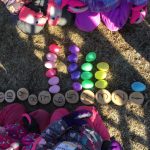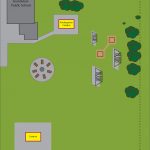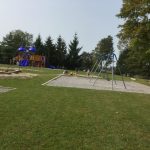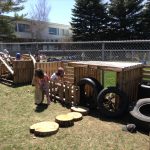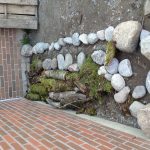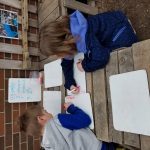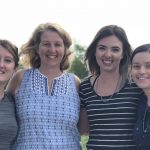The goal of this project was to create, document and measure children’s growth, particularly in numeration, with the use of an outdoor classroom. Inquiry was at the heart of our program. Research shows that children are more focussed and engaged when learning outside (Last Child in the Woods, Richard Louv, 2005). At a time when technology is taking over our lives, being outside is now more important than ever. In Schoolyard Enhanced Learning, by Herbert Broda (2007), he mentions numerous reasons for taking our kids outside, particularly because we are “swimming in an ‘ocean of media’” (Gregory Lamb, 2015, 13). We planned to do a baseline of skills at the beginning of the year. We attended a workshop and toured Evergreen, read quality resources, and shared with each other on Twitter, and within our board, we were able to develop a rich outdoor program. An additional goal was to create a resource or kit that can be shared for those passionate about enhancing their outdoor learning space.
Team Members
Colleen Smyth
Trillium Lakelands District School Board
Gail Pearce
Trillium Lakelands District School Board
Nicolle Reese
Trillium Lakelands District School Board
Danielle DeRusha
Trillium Lakelands District School Board
Professional Learning Goals
- Developed a better understanding of how to better use the outdoors in the area of numeration
- Developed a list of helpful resources (books, blogs, Twitter feeds)
- Developed a cumulating resource to share (online)
- Measured growth using the TLDSB assessment triangle (based on observation, conversation and product)
- Observed/documented the learning growth using the four frames, and using “The Eight Key Concepts in Counting “ from EduGAINS, Guides to Effective Instruction
- Developed a more solid understanding of the early math concepts
- Increased our sense of collaboration amongst the Teacher-ECE partnership and within the FDK teams at our school
Activities and Resources
Activities that helped us meet our goals included visiting Evergreen Brick Works, and participating in a workshop there entitled “How to Design Your Outdoor Space.”
The books we used were:
The Outdoor Classroom in Practice, Ages 3–7: A month-by-month guide to forest school provision by Karen Constable
This book is a “month-by-month guide to forest school provision,” starting in September.
Each chapter is a different month with a few activities to do that are appropriate for the season. Within each chapter, it explains how to prepare, set up, introduce, rules, kits, element of risk, plan, assess, review and to do lists for your outdoor space. The outdoor space in the book does take place in a forest, but the ideas/considerations can be adapted to your own outdoor space. For educators just beginning to teach outdoor, this would be a great introduction of how to get started.
Developing Young Children’s Mathematical Learning Outdoors: Linking Pedagogy and Practice by Lynda Keith
This book has opened up a new mathematical lense for being outdoors. Lynda provides case studies and questions to ask when you are outside to help bring more of a focus to the learning that the children may not know they are doing. Lynda helps break down the educator’s role and the importance of various materials that can be used in an outdoor space. Each chapter breaks down various questions to help narrow down what we are looking for and expecting while we are outside. “We want confident, engaged and focused learners. We want learners that ‘have-a-go’ attitude to learning.” (Keith, 2018).
If you are looking for a book that will help answer any of these questions, this would be a book to help get you started:
How can we plan for effective learning and quality experiences?
What type of young mathematical learners do we want?
How can we support young children in their learning?
Loose Parts: Inspiring Play in Young Children by Lisa Daley and Miriam Beloglovsky
This book is a visual inspiration, providing chapters focusing on provocations related to the senses. It is similar to Pinterest with its many pictures and ideas. This is an ideal book for someone just starting to use loose parts.
Messy Maths: A Playful, Outdoor Approach for Early Years by Juliet Robertson
This book was really our go-to guide for getting started with math ideas we could use in our outdoor classroom. Juliet provides practical tips for organizing your materials, as well as how to use materials that are naturally occurring in your outdoor classroom, such as sticks or leaves. She also gives some really simple tips about what tools you could always carry in your kit, such as a pocket ten frame made out of fabric. This resource gave us lots of inspiration and ideas we could build on. The book is very helpful in that it gave us practical tips about how to get started finding the “maths in that.” I like that it also provided examples of how to set up your learning spaces to bring out the math. Each section is organized by math strands such as measurement, addition, subtraction, etc. which is very user-friendly. She also provides examples of language related to each concept to introduce to learners.
Unexpected Challenges
The weather was the biggest challenge. We tried to be outside three times per week but, if it was extremely cold (-20º) or pouring rain, we were unable to go outside.
We were making the activities too specific and the children seemed to not be enjoying them. We met and decided to revamp how to do the activities with the four frames in mind but insert the eight key concepts.
Another real challenge was time. Time to meet beyond our scheduled meetings, and time for the DECEs to plan and prepare. The reality is that currently DECEs unfortunately do not have prep time for daily activities, regardless of an additional project. These lovely ladies gave a lot of their time before and after school to this project – it wouldn’t have happened without their generosity. It also involved creativity in finding time to chat informally, and find time for them to plan activities and reflect.
Enhancing Student Learning and Development
We created a baseline using “The Eight Key Concepts in Counting” from EduGAINS, Guides to Effective Instruction. We only measured the senior kindergarten students to help narrow our focus. We measured growth using the TLDSB assessment triangle (based on observation, conversation and product). Data was collected three times during the year – October, February and May. This data collection showed us the gaps in learning, and we focused our activities on closing the gaps. We developed a Google Form for documenting the eight key concepts. Professionally, discussions throughout the year helped assess where our inquiry was leading. We were able to see a change in our knowledge base concerning how to best use our outdoor classroom, as well as promoting math effectively.
We were able to enhance student learning in the early skills of numeracy. We focused on one-to-one correspondence, conservation of number, order irrelevance, subitizing, knowledge of quantity, and early operation skills (“The Eight Key Concepts in Counting” from EduGAINS, Guides to Effective Instruction). This outdoor classroom project also supported all areas of the Four Frames of FDK –inquiry, self-regulation, literacy and co-operative play.
Sharing
Each term, we met twice (half-days) to discuss what we had been learning, developed resources, and shared findings in the area of numeracy assessment. We shared our learning throughout our school teams, within our board, during Twitter chats via #tldsbkteach and #tlcmath, and during an open house in June. As a result, we developed a website for outdoor learning related to numeracy that is available online.
We have been sharing our findings with a variety of groups. Sharing occurred regularly with the other two kindergarten teams, as well as with staff at monthly staff meetings. Our learning was shared online through Twitter chats on #tldsbkteach, #tlcmath and regular photos and updates on our board Twitter feed, #tldsblearns. An open house on June 20 is planned for other educators in our area. Weekly updates were shared with parents through Seesaw and newsletters.
Project Evaluation
Colleen: I feel our project was a great success, given our group was at varying stages of our careers – we all got some degree of learning from this fantastic learning experience. For me, personally, I was able to further my knowledge of how to do numeration activities in the outdoors, through any season. Spring and fall always have lots to explore – with this project, I was able to stretch my learning in our cold Canadian winters. The resources we found were invaluable, and will definitely be used in the future. I feel we could say this was successful, as our goal to enhance our numeration knowledge, as well as learning outdoors, showed growth. If I were to do this again, it would have been helpful to have our resources (in particular, Messy Maths and The Outdoor Classroom) earlier to get started, but this will be very helpful in the future. As well, having a map of our yard to write notes about children’s interests will also be very beneficial.
Gail: This was a great project to work on. I started out thinking that we had to evaluate the children and show how they grew in their learning. Once we realized as a group it was about our learning, we shifted our focus. Our outdoor time seemed very unorganized, with no documentation of learning happening. Through this grant, I have found new ways to organize opportunities of learning and document them and also be able to document unorganized play and find the learning that is happening. Our map of our yard was a big success in helping show next steps to guide the learning further in each area of the yard and let other educators know what is happening so they could guide the learning, too.
Nicolle: Throughout this grant, I have learned a lot about the team, working together and the kindergarten program, as well as getting outdoors. Getting outside was new to me, and to bring so much of a numeracy lens at the beginning was a learning curve. Together, we were so focused on the numbers– how well the kids were improving, learning the eight key counting concepts and making sure they were involved in every activity, we missed the big picture.
This was about OUR learning, where our growth was, and what we could do and learn with the children. With that focus we were able to learn so much more. I enjoyed planning because we didn’t have to settle and focus on just the eight key concepts. Once we brought the children outside to see what they wanted to do with the yard, it brought in more possibilities.
That’s when documentation became easier. It was always a bit of a struggle – How do I document for my own class and the others? It had to be something that was able to be shared with the entire team. This is when the yard map idea, as well as physically bringing the documentation outside, helped. With the yard map, we can keep track of different conversations and inquiry that is happening throughout the yard. And bringing some documentation panels outside allowed the children to see what has happened in the different areas around the yard.
The interest of the children came out and, as a team, we were all able to work together with the different inquiries – whether it was birds, ramps or cooking, there were enough adults to work with different children in both classes. We have been able to enjoy seeing the children’s growth and progress throughout the year, doing what they want to do most outside.
Danielle: I think our project was very successful. I am new to FDK this year and taking our learning outdoors. I personally gained a lot of personal growth and learning from this amazing opportunity. We saw a transformation in the way we used our outdoor classroom specifically in the area of numeration. By restructuring the way we planned, I think we began to use it more efficiently and maximized our time outdoors. We also refined the way we looked at observing and documenting the learning and how best to do that throughout the seasons. After using the resources such as Messy Maths and Developing Young Children’s Mathematical Learning Outdoors, I personally gained a better understanding of how to create outdoor activities related to numeracy or to find the “math” that naturally occurs in their play. These were some of the goals we had set for ourselves.
Reflecting on what I might do differently in the future, I would suggest not narrowing our focus too much. Having a mixture of inquiry, provocations and “lessons” or specific tasks in all areas would create a more balanced outdoor program that fits within the Four Frames of the FDK program. Being flexible is key, especially with the weather. Our resources arrived later than we expected which was key in the flexibility piece. However, the list we have created helped me grow and develop a more solid understanding of the early math concepts. They were invaluable in the planning and execution of these activities.
Resources Used
Messy Maths: A Playful, Outdoor Approach for Early Years by Juliet Robertson
ISBN-13: 978-1781352663
The Outdoor Classroom in Practice, Ages 3–7: A month-by-month guide to forest school provision by Karen Constable
ISBN: 978-0-415-72905-5
Developing Young Children’s Mathematical Learning Outdoors: Linking Pedagogy and Practice by Lynda Keith
ISBN: 978-1-138-23715-5
Loose Parts: Inspiring Play in Young Children by Lisa Daley and Miriam Beloglovsky
ISBN-13: 978-1605542744
This is our website we created that gives more details of the learning we experienced.
https://sites.google.com/a/tldsb.net/fdk-outdoor-numeracy/welcome
Resources Created
These resources will open in your browser in a new tab, or be downloaded to your computer.



